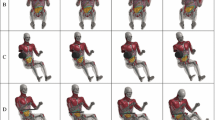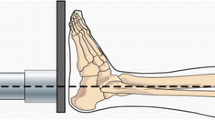Abstract
The scapula, clavicle, humerus, radius and ulna, and bones in the hand are joined by distinct soft tissues and joints in the human. As is true in the other components of the body, these structures are complex and have unique biomechanical characteristics. The purpose of this chapter is to present some of the basic anatomy of this region with a focus on the shoulder and its complex and the forearm. Most of the injuries to this region are high energy injuries. Experimental studies using post mortem human subject (PMHS) delineating the tolerance are described. A considerable majority of tolerance literature due to impact loading is from the automotive area, similar to the other regions. Studies using component models such as isolated forearm and intact PMHS models are described from injuries and injury biomechanics perspectives. Biomechanical testing using component models provide specific loading response information of individual bone and joint, while whole-body PMHS studies facilitate development of injury criteria and understanding of the dynamic interaction between linked components. The chapter concludes with a brief discussion on field injuries and the role of the shoulder in affecting the kinematics, loading and injuries to the thorax, abdomen and pelvis are discussed, with a focus on side impacts. Where possible, injury tolerance information is provided in the form of probability curves.
Access this chapter
Tax calculation will be finalised at checkout
Purchases are for personal use only
Similar content being viewed by others
References
Dempster WT (1965) Mechanisms of shoulder movement. Arch Phys Med Reha 46:49–70
Moore KL (1980) Glenohumeral joint. In: Clinically oriented anatomy. Williams & Wilkins, Baltimore, pp 814–819
Basmajian JV (1969) Recent advances in the functional anatomy of the upper limb. Am J Phys Med 48(4):165–177
Burkart AC, Debski RE (2002) Anatomy and function of the glenohumeral ligaments in anterior shoulder instability. Clin Orthop Relat Res 400:32–39
Robinson CM (1998) Fractures of the clavicle in the adult. Epidemiology and classification. J Bone Joint Surg Br 80(3):476–484
Duprey S, Bruyere K, Verriest J-P (2008) Influence of geometrical personalization on the simulation of clavicle fractures. J Biomech 41(1):200–207
Harrington MA Jr, Keller TS, Seiler JG 3rd, Weikert DR, Moeljanto E, Schwartz HS (1993) Geometric properties and the predicted mechanical behavior of adult human clavicles. J Biomech 26(4–5):417–426
Kemper A, Stitzel J, Gabler C, Duma S, Matsuoka F (2006) Biomechanical response of the human clavicle subjected to dynamic bending. Biomed Sci Instrum 42:231–236
Weber C (1859) Chirurgische Erfahrungen und Untersuchungen, pp. 171–174. (cited in Melvin 1995)
Melvin JW (1995) Injury assessment reference values for the CRABI 6-month infant dummy in a rear-facing infant restraint with airbag deployment. SAE Congress, Detroit
Messerer O (1880) U X ber ElasticitaX t und Festigkeit der menschlichen Knochen. Stuttgart: J. G. Cotta’schen Buchhandlung. (cited in Melvin, 1995)
Yamada H (1970) In: Evans FG (ed) Strength of biological materials. Williams and Wilkins, Baltimore
Kirkish SL, Begeman PC, Paravasthu NS (1996) Proposed provisional reference values for the humerus for evaluation of injury potential. Paper no. 962416. Society of Automotive Engineers, Warrendale
Mertz HJ (1984) A procedure for normalizing impact response data. Society for Automotive Engineers, Warrendale
Duma S, Schreiber P, McMaster J, Crandall J, Bass C, Pilkey W (1998) Dynamic injury tolerances for long bones of the female upper extremity. In: Proceedings of the 1998 International IRCOBI Conference on the Biomechanics of Impact. Sept. 16–18, 1998; Göteberg, Sweden. pp 189–201
Eppinger RH, Marcus JH, Morgan RM (1984) Development of dummy and injury index for NHTSA’s thoracic side impact protection research program. Paper no. 840885. Society of Automotive Engineers, Warrendale
van Rooij L, Bours R, van Hoof J, Mihm JJ, Ridella SA, Bass CR, Crandall JR (2003) The development, validation and application of a finite element upper extremity model subjected to air bag loading. Stapp Car Crash J 47:55–78
Bass CR, Duma SM, Crandall JR, Morris R, Martin P, PIlkey WD (1997) The interaction of air bags with upper extremities. Paper no. 973324. Society of Automotive Engineers, Warrendale
Pintar FA, Yoganandan N (2002) Dynamic bending tolerance of the human forearm. Traffic Inj Prev 3:48–52
Mather BS (1967) A method of studying the mechanical properties of long bones. J Surg Res 7(5):226–230
Mather BS (1967) Correlations between strength and other properties of long bones. J Trauma 7(5):633–638
Hardy WN, Schneider LW, Rouhana SW (2001) Prediction of airbag-induced forearm fractures and airbag aggressivity. Stapp Car Crash J 45:511–534
Duma SM, Hansen GA, Kennedy EA, Rath AL, McNally C, Kemper AR, Smith EP, Brolinson PG, Stitzel JD, Davis MB, Bass CR, Brozoski FT, McEntire BJ, Alem NM, Crowley JS (2004) Upper extremity interaction with a helicopter side airbag: injury criteria for dynamic hyperextension of the female elbow joint. Stapp Car Crash J 48:155–176
Duma SM, Boggess BM, Crandall JR, Mac Mahon CB (2002) Fracture tolerance of the small female elbow joint in compression: the effect of load angle relative to the long axis of the forearm. Stapp Car Crash J 46:195–210
Bolte JH, Hines MH, McFadden JD, Saul RA (2000) Shoulder response characteristics and injury due to lateral glenohumeral joint impacts. Stapp Car Crash J 44:261–280
Compigne S, Caire Y, Quesnel T, Verries JP (2004) Non-injurious and injurious impact response of the human shoulder three-dimensional analysis of kinematics and determination of injury threshold. Stapp Car Crash J 48:89–123
Irwin A, Walilko T, Cavanaugh J, Zhu Y, King A (1993) Displacement responses of the shoulder and thorax in lateral sled impacts. In: Stapp car crash conference, San Antonio, pp 166–173
Koh SW, Cavanaugh JM, Zhu J (2001) Injury and response of the shoulder in lateral sled tests. Stapp Car Crash J 45:101–142
Duma SM, Crandall JR, Hurwitz SR, PIlkey WD (1998) Small female upper extremity Interaction with a deploying side air bag. Society of Automotive Engineers, Warrendale. Paper no. 983148
Melvin JW, Baron KJ, Little WC, Gideon TW, Pierce J (1998) Biomechanical analysis of Indy race car crashes. Society of Automotive Engineers, Warrendale. Paper no. 983161
Yoganandan N, Stadter GW, Halloway DE, Pintar FA (2013) Injury patterns to other body regions and load vectors in nearside impact occupants with and without shoulder injuries. Ann Adv Autom Med. Annual Scientific Conference Association for the Advancement of Automotive Medicine Association for the Advancement of Automotive Medicine 57:133–144
Stadter GW, Yoganandan N, Halloway DE, Pintar FA Analysis of nearside narrow object impacts with and without shoulder injuries in real-world crashes. In: IRCOBI, Gotenborg, Sweden, 13–15 Sept 2013
AIS (1990) The abbreviated injury scale, 1998 update. American Association for Automotive Medicine, Arlington Heights
Yoganandan N, Pintar FA (2005) Odontoid fracture in motor vehicle environments. Accid Anal Prev 37(3):505–514. doi:10.1016/j.aap.2005.01.002
Yoganandan N, Humm JR, Pintar FA, Brasel K (2011) Region-specific deflection responses of WorldSID and ES2-re devices in pure lateral and oblique side impacts. Stapp Car Crash J 55:351–378
Yoganandan N, Humm JR, Pintar FA (2012) Modular and scalable load-wall sled buck for pure-lateral and oblique side impact tests. J Biomech 45(8):1546–1549. doi:10.1016/j.jbiomech.2012.03.002
Yoganandan N, Humm JR, Pintar FA, Maiman DJ (2013) Determination of peak deflections from human surrogates using chestbands in side impact tests. Med Eng Phys. doi:10.1016/j.medengphy.2012.12.012
Yoganandan N, Humm JR, Pintar FA, Brasel K (2012) Deflection responses post mortem human surroagtes in pure lateral and oblique side impacts. Stapp Car Crash J 55:351–378
Yoganandan N, Pintar FA, Sances A Jr, Walsh PR, Ewing CL, Thomas DJ, Snyder RG (1995) Biomechanics of skull fracture. J Neurotrauma 12(4):659–668
Yoganandan N, Pintar FA (2004) Biomechanics of temporo-parietal skull fracture. Clin Biomech (Bristol, Avon) 19(3):225–239. doi:10.1016/j.clinbiomech.2003.12.014
Lessley D, Shaw G, Parent D, Arregui-Dalmases C, Kindig M, Riley P, Purtsezov S, Sochor M, Gochenour T, Bolton J, Subit D, Crandall J, Takayama S, Ono K, Kamiji K, Yasuki T (2010) Whole-body response to pure lateral impact. Stapp Car Crash J 54:289–336
Kuppa S, Eppinger RH, McKoy F, Nguyen T, Pintar FA, Yoganandan N (2003) Development of side impact thoracic injury criteria and their application to the modified ES-2 dummy with Rib extensions (ES-2re). Stapp Car Crash J 47:189–210
Maltese MR, Eppinger RH, Rhule HH, Donnelly BR, Pintar FA, Yoganandan N (2002) Response corridors of human surrogates in lateral impacts. Stapp Car Crash J 46:321–351
Yoganandan N, Pintar FA, Stemper BD, Gennarelli TA, Weigelt JA (2007) Biomechanics of side impact: injury criteria, aging occupants, and airbag technology. J Biomech 40(2):227–243. doi:10.1016/j.jbiomech.2006.01.002
Acknowledgments
This material is the result of work supported with resources and the use of facilities at the Zablocki VA Medical Center, Milwaukee, Wisconsin and the Medical College of Wisconsin. Narayan Yoganandan is a part-time employee of the Zablocki VA Medical Center, Milwaukee, Wisconsin. Any views expressed in this chapter are those of the authors and not necessarily representative of the funding organizations.
Author information
Authors and Affiliations
Corresponding author
Editor information
Editors and Affiliations
Rights and permissions
Copyright information
© 2015 Springer Science+Business Media New York
About this chapter
Cite this chapter
Wang, M., Rao, R.D., Yoganandan, N., Pintar, F.A. (2015). Upper Extremity Injury Biomechanics. In: Yoganandan, N., Nahum, A., Melvin, J. (eds) Accidental Injury. Springer, New York, NY. https://doi.org/10.1007/978-1-4939-1732-7_12
Download citation
DOI: https://doi.org/10.1007/978-1-4939-1732-7_12
Published:
Publisher Name: Springer, New York, NY
Print ISBN: 978-1-4939-1731-0
Online ISBN: 978-1-4939-1732-7
eBook Packages: MedicineMedicine (R0)




